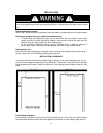
10
CLEANING AND MAINTENANCE
Defrosting
Note: To avoid damaging the freezing compartment wall, never use a sharp or metallic instrument to
scrape off frost or separate the frozen food.
Moisture contained in food and air may form a layer of frost inside the unit after a period of use.
We highly recommend that the unit gets defrosted when frost becomes ¼” thick. The defrosting process
for this unit is operated manually.
For complete defrosting:
1. Turn the temperature control knob to OFF and unplug from wall socket
2. Remove all food and place it in corrugated boxes, insulated bags, picnic cooler, etc. Use
towels and newspaper for insulation as needed.
3. With the door open, use pans of hot water to speed the loosening of the frost. Remove
large pieces of before they melt
4. Sponge excess water from the bottom of the freezer as it collects to prevent overflowing
5. After defrosting, clean the inside of the freezer by using a soft cloth to wipe away the
remaining ice and water (see Cleaning Your Freezer)
6. Once the compartment is wiped and dry, plug in the freezer. Return the temperature control
knob to its previous position and return food to the freezer.
NOTE: Do not use mechanical devices or other means to accelerate the defrosting process. DO NOT
pour hot water directly into compartment or heat with hair dryer while defrosting, which may warp the
inner case.
Cleaning Your Upright Freezer
Keep the finish clean
Wipe with a clean cloth lightly dampened with appliance polish wax or mild liquid dishwashing
detergent. Dry and polish with a clean, soft cloth. Do not wipe the freezer with a soiled dishwashing cloth
or wet towel. Do not use scouring pads, powdered cleaners, bleach, or cleaners containing bleach.
Inside
Clean the inside of your freezer at least once a year. We recommend that the freezer be unplugged
before cleaning. If this is not practical, wring excess moisture out of sponge or cloth when cleaning in
the vicinity of switches, lights or controls. Use warm water and baking soda solution–about a tablespoon
of baking soda to a quart of water. Rinse thoroughly with water and wipe dry. Do not use cleaning
powders or other abrasive cleaners. DO NOT wash removable parts in a dishwasher. An open box of
baking soda in the freezer will absorb stale freezer odors. Change the box every three months.
NOTE:
Care should be taken in moving the freezer away from the wall. All types of floor coverings can
be damaged, particularly cushioned coverings and those with embossed surfaces.
Damp objects stick to cold metal surfaces. DO NOT touch interior metal surfaces with wet or
damp hands.
Freezer must be unplugged to avoid electrical hazard from power source when defrosting unit.
Before proceeding with cleaning and maintenance operations, make sure the power line of the unit is
disconnected. Do not touch the power plug when your hands are wet. Never unplug the unit by pulling on
the plug.















